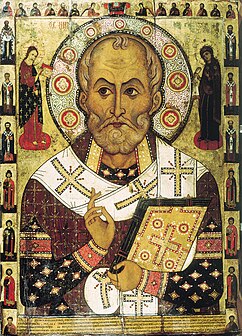Although Santa isn't technically a fairy tale, the more I learn the more I'm amazed by the paralells between the evolution of faerie and the evolution of St. Nicholas to Santa Claus.
Fairies were once feared and regarded to be unpredictable creatures, who could range from malevolent to merely capricious pranksters, but hardly ever in the history of fairy lore were fairies the beneficient, wish-granting characters they are painted as today, nor were they necessarily miniature and winged.
St. Nicholas was not fearsome in the sense that he was evil or unpredictable, but he was held in awe by his followers. According to legends, he not only had the power to predict and prevent disasters, but to restore the innocent to life, as well as take a life as punishment for crime.
Read my post from last year on the stories of the three girls rescues from prostitution or slavery, which is thought to be the origin of the tradition of hanging stockings, or the story of the three murdered students St. Nicholas brought back to life (which includes gruesome details, much like the fairy tale Robber Bridegroom).
St. Nicholas was also the patron saint of sea travelers, and many stories include him appearing in dreams, or in person (even after his death) to sailors to warn them of storms and redirect them, work with them, even restore a sailor to life who had perished in a storm. Because of the story of the students referenced above, he became the patron saint of students as well. Over time, illustrations and versions of that story created students that were younger and younger, until they became children, and he eventually became the patron saint of children in general. There is also a story of him returning a boy from slavery to his parents on his feast day (today, December 6!) which aided in his image as protector of children. In fact, as stories developed and spread throughout Europe and Russia and parts of Africa, he became the patron saint of practically everyone-from pawnbrokers to vagabonds. He also eventually came to be associated with restoring happiness and wealth, and later into the Giver of Gifts we know him as.
St. Nicholas was also associated with stories involving the number three-three generals or three students saved from death, three episodes-a characteristic of folk tales as well.
Throughout the Middle Ages, it became common for plays to be performed on his feast day enacting scenes of his life and miracles. Though the plays could get a bit bawdy at times, or light-hearted poking fun at an image usually regarded with supreme reverence, the happy ending justified the rest of the play. Already we see a beginning of a transformation of attitudes-from fear and awe of his earlier worshipers, to a figure of celebration and fun.
Though there may be some remnants of folklore in the Santa Claus traditions we currently have (the Swedish Jul-Bocken, or Christmas buck, that bore presents, relate to Santa's reindeer, and his fur coat is similar to that of Pelz-Nicol in southern Germany) Santa Claus as we know him is the product of three specific men in New York in the nineteenth century.
Washington Irving wrote a spoof history of the Dutch immigrants that included references to St. Nicholas, thus reminding the American population of this once-venerated figure in Europe. Influenced by this, Clement Clarke Moore wrote his famous "A Visit From St. Nicholas" (now more commonly known as "The Night Before Christmas") in 1822. Thomas Nast's illustrations of Santa Claus transformed him from the once thin (literally, thin enough to fit through a chimney) to the rotund figure we see in so many commercials, shopping malls, and storefronts around this time of year. Rather like Charles Perrault did to Cinderella, the elements we now think of as ageless really sprang up due to these three men-building toys in the North Pole, records of good and bad children, receiving and answering children's letters, and driving his reindeer-none of these ideas were associated with Santa previous to New York in the early nineteenth century.
To put this in perspective, as Santa Claus was becoming more and more a jolly children's figure, the standard fairy tale versions we know were being created-the Grimm brothers' collection first published in Germany in 1812. The relatively new phenomenon of children's literature was affecting the images of folk tales and saints alike, transforming them into "child-appropriate" in such a way that their earlier histories have become all but erased from present knowledge.
What does this history of Santa Claus mean? In the words of Martin Ebon, the versions of Santa Claus reflect the surrounding culture more than anything else, as we adapt our folklore to meet our needs (just like the evolution of fairy tales). Wherever there was a need, St. Nicholas was there to calm fears and instill hopes-from the dangers of the sea, to those of travelling students, to the vulnerability of children in general. "He is what he is today, as Santa Claus, because we yearn for a season of altruism, childlike innocence, and 'Peace on Earth.'"
*All information from Martin Ebon's Saint Nicholas: Life and Legend





This is great, and fascinating, and fodder for a discussion some friends were having on facebook about whether or not kids should be raised "believing" in Santa Claus. Thanks for putting this all together!
ReplyDeleteHappy (belated) Saint Nicholas Day! My son is almost two, and Father Christmas/Santa Claus will be a welcome guest in our household, just like fairy tales. So suck it up, Charles Dawkins! c;
ReplyDeleteThanks for posting about this beautiful tradition. St. Nicholas, pray for us.